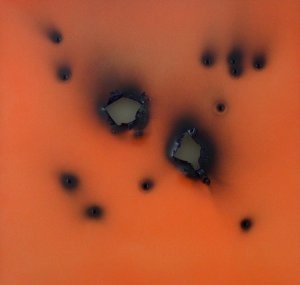
In the exhibition announcement for "Adaptation Syndrome: Painting in Contemporary Image Culture" curators Dinah and Paul Ryan ask, "When almost anyone can create an arresting visual image, how do painters respond?" This refers to the fact that, in this age of high technology and seemingly unlimited possibilities, "Contemporary culture has become in many respects more creative than visual art.
In the exhibition announcement for "Adaptation Syndrome: Painting in Contemporary Image Culture" curators Dinah and Paul Ryan ask, "When almost anyone can create an arresting visual image, how do painters respond?" This refers to the fact that, in this age of high technology and seemingly unlimited possibilities, "Contemporary culture has become in many respects more creative than visual art. A difficult, albeit real quandary to propose, it is one these two curator/critics answer with some weighty examples.
Scott Barber takes a cue from science, and military technology and blends sound principles of composition with a sort of heat sensitive photography esthetic to produce two untitled alkyd urethane on aluminum paintings which command ones attention, while Jane Callister’s psychedelic landscapes of displaced land masses and reality bending colors charms the subconscious.
Margaret Evangeline’s mark makers are bullets. Her pierced metal surfaces suggest a sort of universal reality that crosses all colors and classes. These two new works, "Polychromaculate #3" (2004) and "Polychromaculate #4" (2004) are a bit different from her more familiar polished metal surfaces because color is added into the mix. Here, she colors the assaulted aluminum with oil paint which enhances the balance between the violent act of targeting the metal a multitude of times, with the intriguing, even alluring effect of the mangled surfaces.
Written by Dominick Lombardi